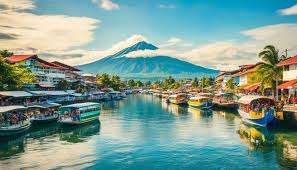Davao, Gateway to Mindanao’s Wonders, offers a diverse blend of natural beauty, vibrant culture, and adventure, with Mt. Apo and pristine beaches nearby.
ADVERTISEMENT

Table of Content

Davao: Gateway to Mindanao’s Wonders
Davao: Gateway to Mindanao’s Wonders is a vibrant and bustling city in the southern Philippines that serves as the main entry point to the island of Mindanao’s diverse natural and cultural attractions. It is known for its rich blend of urban development, indigenous culture, and stunning natural beauty. Davao is home to Mount Apo, the highest peak in the Philippines, making it a haven for adventurers and nature lovers. The city is also famous for its pristine beaches, eco-parks, and the Philippine Eagle Center, dedicated to the conservation of the endangered Philippine eagle.
Davao’s cultural diversity, with influences from indigenous tribes like the Bagobo, Mandaya, and Manobo, as well as Spanish, American, and Japanese heritage, gives it a unique identity. It is also renowned for its delicious tropical fruits, especially durian, and vibrant festivals like the Kadayawan Festival, celebrating the region’s indigenous roots and bountiful harvests.
As the economic and commercial hub of Mindanao, Davao serves as the gateway to exploring the island’s natural wonders, including waterfalls, diving spots, and lush landscapes, making it a key destination for both adventure-seekers and those looking to experience the rich cultural heritage of the southern Philippines.
I. Introduction
Davao City, located in the southern Philippines, is known as the “Gateway to Mindanao’s Wonders” due to its strategic location and rich offering of natural, cultural, and adventure attractions. As one of the largest cities in the Philippines in terms of land area, Davao serves as a hub for eco-tourism, outdoor activities, and cultural exploration, making it a prime destination for both local and international tourists.
Key Attractions and Appeal:
Davao: Gateway to Mindanao’s Wonders offers a diverse array of experiences, from the majestic heights of Mount Apo to the tranquil beaches of Samal Island. The city seamlessly blends its modern urban landscape with cultural heritage and access to nearby natural wonders, positioning it as a central point for exploring Mindanao.
II. Natural Attractions
Mount Apo:
The Philippines’ Highest Peak:
Mount Apo, towering at 2,954 meters (9,692 feet), is the highest mountain in the Philippines and is revered by both local tribes and adventurers. It is a popular destination for trekkers and mountaineers, offering a challenging yet rewarding climb with panoramic views from the summit.
Biodiversity and Conservation:
Mount Apo is a biodiversity hotspot, home to rare and endangered species such as the Philippine eagle, along with a variety of flora and fauna. The mountain’s unique ecosystems include mossy forests, grasslands, and volcanic craters, making it a vital site for conservation efforts and ecological studies.
Trekking Routes:
Several routes lead to Mount Apo’s summit, each offering varying levels of difficulty. Trekkers can pass through forests, rivers, and sulfur vents, and experience the changing terrain and climate as they ascend the mountain.
Samal Island (Island Garden City of Samal):
Pristine Beaches and Resorts:
Located just off the coast of Davao City, Samal Island is known for its white-sand beaches, crystal-clear waters, and luxurious resorts. It’s a popular destination for those seeking relaxation and water activities, making it an ideal getaway for tourists and locals alike.
Diving and Snorkeling:
Samal Island is home to vibrant coral reefs, providing excellent spots for snorkeling and diving. Popular dive sites like Angel’s Cove and Coral Garden are teeming with marine life, offering an unforgettable underwater experience.
Hagimit Falls and Monfort Bat Cave:
Aside from its beaches, Samal Island also features natural attractions like Hagimit Falls, a cascading waterfall surrounded by lush greenery, and Monfort Bat Cave, home to the world’s largest colony of fruit bats, a unique ecological site that is both educational and awe-inspiring.
Philippine Eagle Center:
Conservation and Education:
The Philippine Eagle Center is a sanctuary dedicated to the preservation of the critically endangered Philippine eagle, the national bird of the Philippines. Visitors can see these majestic eagles up close and learn about the center’s breeding and rehabilitation programs.
Wildlife Encounters: In addition to eagles, the center is home to other species of birds, mammals, and reptiles native to the Philippines. Educational tours focus on wildlife conservation and the importance of protecting the country’s natural resources.
III. Cultural and Historical Sites
Museo Dabawenyo:
Preserving Davao’s History:
Museo Dabawenyo is a cultural and historical museum that highlights Davao’s rich history, indigenous heritage, and the city’s evolution from its early beginnings to the modern metropolis it is today. The museum features exhibits on local tribes, artifacts from the Spanish colonial period, and key historical figures in Davao’s development.
Indigenous Tribes:
The museum showcases the traditions and way of life of Davao’s indigenous communities, including the Bagobo, Manobo, and Mandaya tribes. Visitors can learn about their unique customs, craftsmanship, and contributions to the region’s cultural identity.
Kadayawan Village:
Cultural Immersion:
Located within Magsaysay Park, Kadayawan Village is a cultural exhibit showcasing the traditional homes and way of life of Davao’s indigenous tribes. The village is a highlight during the annual Kadayawan Festival, but it remains open year-round for visitors interested in exploring the region’s tribal heritage.
Indigenous Architecture and Crafts:
The village features full-scale replicas of indigenous homes made from native materials, along with exhibits of traditional crafts such as weaving, pottery, and jewelry-making, allowing visitors to experience the rich cultural traditions of Mindanao’s indigenous people.
Japanese Tunnel:
World War II History:
The Japanese Tunnel is a historical site built by Japanese soldiers during World War II. It was used as a hideout, storage for weapons, and as a command center during the occupation. Visitors can explore the underground tunnels and see wartime relics, including a shrine and statues of Japanese soldiers, offering a glimpse into Davao’s wartime past.
IV. Parks and Recreation
People’s Park:
City Oasis:
People’s Park is a well-maintained public park in the heart of Davao City. Known for its beautifully landscaped gardens, the park also features a durian-shaped dome and sculptures representing indigenous peoples. It is a popular spot for leisurely walks, family outings, and community events.
Cultural Sculptures:
The park’s prominent sculptures, created by local artist Kublai Millan, depict indigenous culture and figures, serving as a tribute to Davao’s rich cultural heritage.
Eden Nature Park:
Mountain Resort Experience:
Eden Nature Park is a sprawling mountain resort located on the outskirts of Davao City. It offers a variety of activities, including hiking, bird-watching, horseback riding, and zip-lining, along with stunning views of the Davao Gulf.
Eco-Tourism and Sustainability:
The park promotes eco-tourism and sustainable practices, offering farm-to-table meals using organic produce grown on-site. It’s an ideal destination for families and nature lovers looking to escape the hustle and bustle of the city.
Crocodile Park:
Wildlife Park:
Davao Crocodile Park is home to a variety of reptiles, including hundreds of crocodiles, as well as exotic animals like tigers, birds, and snakes. The park offers live feeding shows, educational tours, and the opportunity to learn about wildlife conservation efforts in the Philippines.
Conservation Awareness:
The park also serves as an educational facility, teaching visitors about the importance of protecting endangered species and their natural habitats.
V. Adventure and Eco-Tourism
Trekking and Hiking:
Mount Apo Expeditions:
Davao is the starting point for expeditions to Mount Apo, with several trekking routes that range from beginner to advanced levels. These treks offer scenic views, encounters with diverse wildlife, and opportunities for camping in the mountain’s unique ecosystems.
Nature Trails:
For less strenuous adventures, visitors can enjoy nature trails in Eden Nature Park or the Davao City Watershed area, which offers beautiful views and the chance to explore Davao’s natural landscapes.
Water Sports and Activities:
Samal Island Water Adventures:
Samal Island offers a wide range of water activities, including snorkeling, diving, jet-skiing, and paddleboarding. Its rich marine biodiversity and crystal-clear waters make it a top destination for water sports enthusiasts.
Beach Resorts:
Samal Island is dotted with luxury and budget-friendly resorts that provide access to various water activities, making it a versatile destination for different types of travelers.
Philippine Eagle Center:
Visitors can participate in interactive tours at the Philippine Eagle Center, where they learn about the efforts to rehabilitate and conserve the Philippine eagle and other wildlife.
Crocodile Park:
At Crocodile Park, visitors can observe live feeding shows and gain insight into the behavior and habitats of various reptiles and exotic animals.
VI. Culinary Experiences
Durian and Tropical Fruits:
Durian Capital:
Davao is known as the “Durian Capital of the Philippines” due to its abundance of this spiky, strong-scented fruit. While the taste is an acquired one, durian lovers can find the freshest varieties in the city’s markets.
Fruit Markets:
Davao’s tropical climate makes it an ideal location for growing fruits like mangosteen, pomelo, marang, and bananas. The city’s fruit markets are a must-visit for food lovers looking to sample the best produce Mindanao has to offer.
Local Cuisine:
Sinuglaw and Kinilaw:
Davao’s food scene offers a blend of traditional and modern dishes. Sinuglaw, a combination of grilled pork and raw fish marinated in vinegar, is a popular local delicacy. Kinilaw, a Filipino-style ceviche, highlights the freshness of local seafood.
Tuna Dishes: As a coastal city, Davao is famous for its fresh seafood, particularly its tuna dishes, which can be found in many restaurants and food markets throughout the city.
VII. Festivals and Events
City’s Founding Celebration: Araw ng Dabaw, or Davao Day, marks the city’s founding anniversary every March. The celebration includes city-wide activities such as parades, concerts, sporting events, and beauty pageants, reflecting Davao’s vibrant community spirit.
Kadayawan Festival:
Celebration of Culture and Harvest: The Kadayawan Festival, held every August, is Davao’s most popular festival. It celebrates the region’s bountiful harvest, rich cultural heritage, and the unity of its people. The festival features street parades, traditional dances, and exhibitions of indigenous crafts and produce.
Indigenous Tribes Representation:
The festival showcases the culture and traditions of the 11 indigenous tribes of Davao, providing a platform for these communities to celebrate their heritage through performances and rituals.
Araw ng Dabaw
Araw ng Dabaw, or Davao Day, marks the city’s founding anniversary every March. The celebration includes city-wide activities such as parades, concerts, sporting events, and beauty pageants, reflecting Davao’s vibrant community spirit.
Conclusion
Davao truly lives up to its title as the “Gateway to Mindanao’s Wonders,” offering a remarkable blend of natural beauty, cultural richness, and adventure. From the majestic Mount Apo and the pristine shores of Samal Island to the conservation efforts at the Philippine Eagle Center, Davao provides experiences that cater to nature lovers, history enthusiasts, and adventure seekers alike. With its vibrant local culture, delicious cuisine, and a commitment to preserving its natural and historical treasures, Davao invites travelers to explore the best of Mindanao and discover its unique wonders.
Disclaimer
The information provided about Davao is intended for general informational purposes only. While efforts have been made to ensure accuracy, details regarding attractions, operating hours, and activities may change. Visitors are encouraged to verify information with local authorities or tourism offices before planning their trip. This content does not guarantee specific experiences or availability of services mentioned. Always respect local customs, regulations, and natural environments while exploring Davao.
About author
Kween Yulo is a seasoned SEO writer with 15 years of experience, specializing in diverse niches across the digital landscape. Her expertise spans various industries, including gaming, e-commerce, finance, travel, and lifestyle. Known for crafting engaging, optimized content, Kween’s writing is tailored to boost search rankings and enhance user engagement. Her deep understanding of SEO trends, keyword strategies, and audience behavior has made her a trusted content creator for businesses seeking to strengthen their online presence. Kween’s versatility and dedication to quality make her an asset in any digital content strategy.


